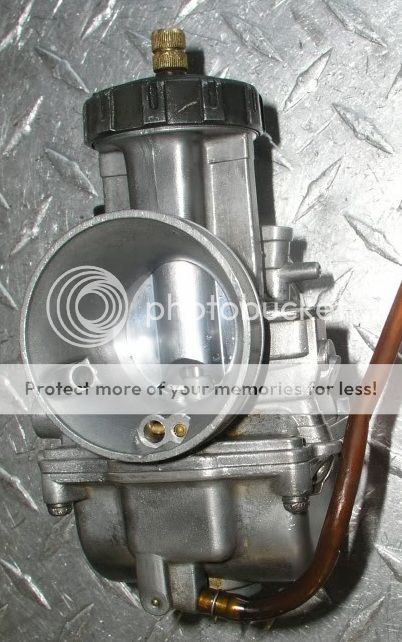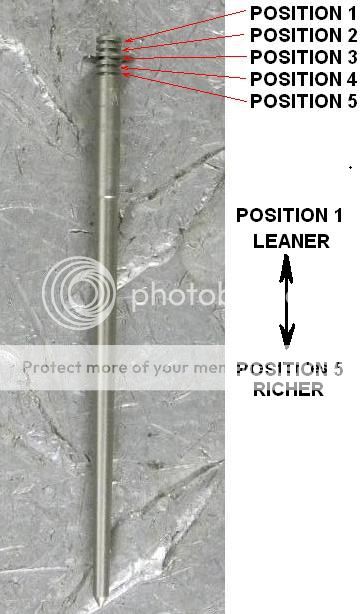Sounds easy right?
If it were easy, everyone would have perfectly jetted bikes.
Yet, most of the bikes I hear and see are running rich or lean (More rich then lean).
In fact, one of the easiest and cheapest ways to make more power is to jet your bike taking into account all the variables.
That's right, jetting = power.
If your bike has not been jetted correctly you will almost certainly gain power somewhere and likely everywhere in your RPM range.
In this discussion I will attempt to give you what you need to safely jet your bike.
Let me be clear up front, I have been riding and playing on bikes for many years but I do not consider myself a master mechanic.
Therefore I have enlisted the help of a few people that I do consider Master mechanics.
I'm certain that we can give you enough good information that you will find the discussion informative and highly accurate.
So, before I get into this in depth, do you know someone with a dyno?
Do they Jet bikes for a reasonable fee?
If so, why not take it to them, drop it off, pay the money, and be happy?
First off, you don't want your bike tuned for absolute peak power because you would be running lean and frag your engine.
Let's say that he will tune your engine just a little rich off of peak HP, what then?
If you took it to your buddy and his dyno is at sea level and he jetted your bike, then you take it up a few thousand feet in elevation and ride it, your loosing power. Why? Because the air has more density at lower elevations then in higher elevations.
So, your bike will be blubbery and sluggish the higher you go because it will be running rich.
I have specific jets for different places I ride.
This is a good spot to discuss what things can effect your jetting and why.
If I'm at sea level I have one set of jets.
If I'm in the high desert I run another.
Why? Again the air has more density at lower elevations then in higher elevations.
It stands to reason that anything you modify, replace, or change in your fuel system, intake system, combustion chamber, exhaust valves, porting, exhaust system, fuel quality, type of oil, type or style of air cleaner, oil to gas ratio, condition of crank seals, and condition of your top end in general, will change your jetting needs.
Did I mention the weather is a factor?
That's right, hot days will require leaner jetting and cold weather requires richer jetting.
Why is that?
Think about it this way.
The more air you let into the combustion chamber, the more fuel you need or your bike will run lean.
Conversely, the less air you allow into the combustion chamber, the less fuel you will need or it will run rich.
So what does this have to do with the weather?
What happens when you heat the air up?
The molecules move faster and further apart.
See the chart below.
Note how few Air molecules there are.
Because they are hotter, they vibrate faster and push the surrounding air molecules farther away giving you less air in the combustion chamber:

What happens when you cool the air down?
The molecules move slower and move closer together.
They do this because they are colder, they vibrate slower and can't push the surrounding air molecules farther away:

Note that on both charts there is the same amount of fuel entering the combustion chamber regardless of air temperature.
So it's winter out and it's 10 degrees, the air is going to be extremely dense (Molecules are closer together).
This means that your engine will be allowing more air molecules into the combustion chamber, thus requiring more fuel.
Let's say that it's in the middle of the summer, your in the desert, and it's 110 degrees.
The air will be a lot less dense (Molecules are further apart).
That means that you will be letting in a lot less air into the combustion chamber requiring a lot less less fuel.
Humidity also has an effect on jetting.
Remember, anything that lets less air into the combustion chamber makes it run richer.
If it's humid the water molecules in the air are taking the place of air molecules.

So, less air, you need less fuel.
Suppose your riding at the coast and a huge storm hits as you are 20 miles from camp.
There will be even more water molecules in the air, taking up more valuable space in your combustion chamber for those air molecules.
If your bike was already jetted extremely rich when you started the day, you might end up fouling a plug before you make it back to camp
Ever wonder why there are few jetting charts out there?
The few that you will find including the K5 chart on my site are very conservative and are only meant for a starting point.
http://www.oem-cycle.com/KX500JETTINGGUIDE.shtml
The reason why charts are conservative is because if you run your bike rich you may not get all the power it can produce and you might fowl some plugs but, you will not burn it up.
Run your engine too lean and it will be down on power and you risk melting your piston to your cylinder wall or welding your connecting rod to your crank
Before we get into the technical part of this discussion we are going to assume that your engine, fuel system, and exhaust system, is in good over all condition.
If your bike has mechanical issues, jetting your carb won't fix the underlying problem and is really a waste of time.
Fix your problems first, make your engine mods, put on that shiny new dent free pipe, repack your muffler, decide what fuel, oil, and ratio your going to use, mod your air box, make sure that your carburetor floats are correctly set, and that your carburetor is super clean inside and out, then look at your jetting.
Remember, if you get your carb perfectly jetted and then change anything in the system, you get to start jetting all over again!
Since I ride a K5, I will post pics of a Keihin carburetor off a 2000 KX 500.

One last thing before I begin, I recommend that you make one change at a time.
Otherwise all you will do is go round in circles in trying to figure out where your jetting should be.
Now for the technical side.










